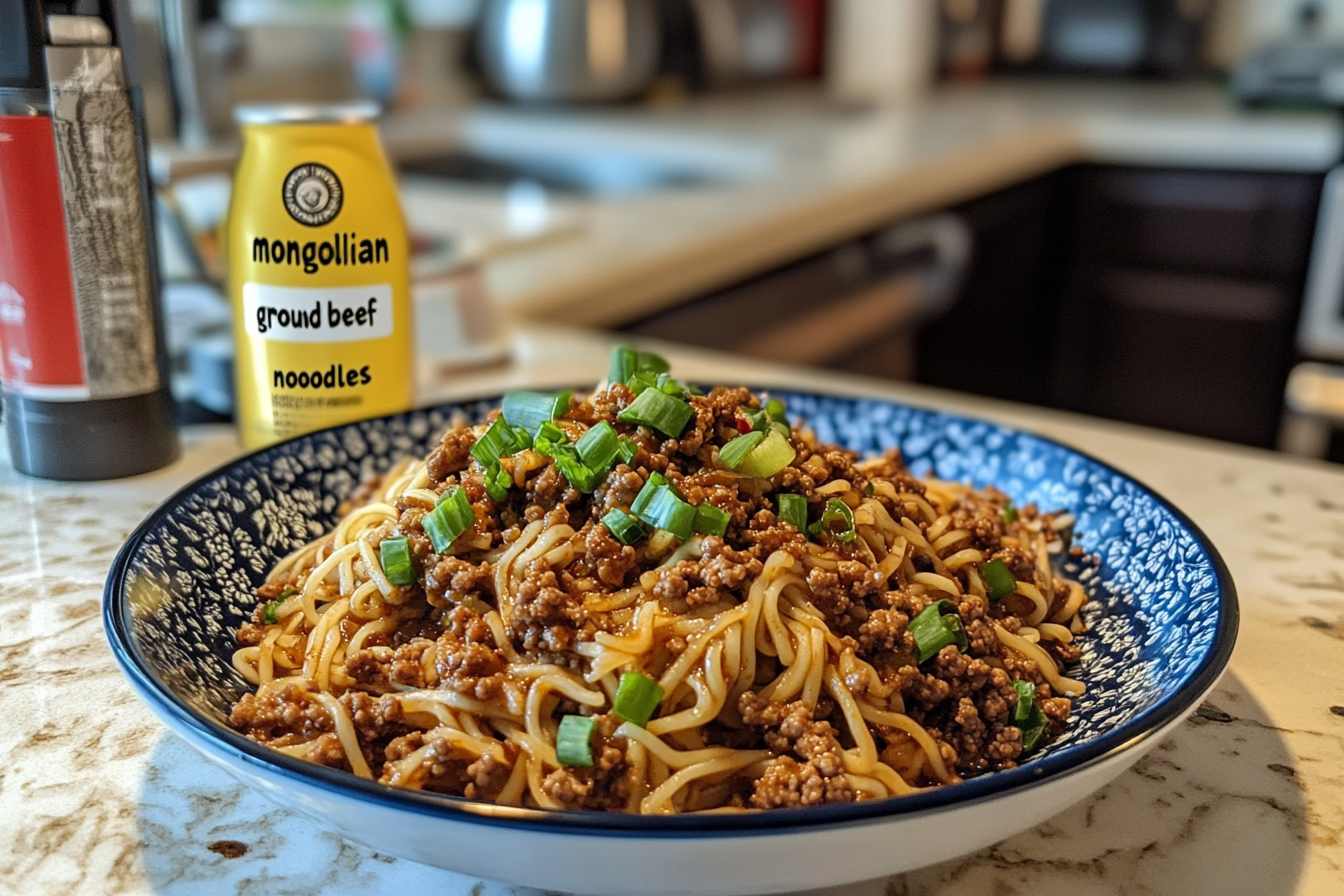Introduction and Basics
1. What Are Mongolian Ground Beef Noodles?
Mongolian ground beef noodles are a savory and slightly sweet dish that combines tender noodles, flavorful ground beef, and a rich sauce inspired by Mongolian flavors. While not traditionally Mongolian, this dish takes cues from the bold, umami-rich flavors found in Mongolian barbecue recipes, creating a fusion-style comfort meal.
This dish is perfect for busy weeknights or when you’re craving something quick, hearty, and packed with flavor. Its simplicity and adaptability make it a favorite among home cooks.
2. Why Choose This Recipe?
Here’s why Mongolian ground beef noodles deserve a spot on your dinner table:
- Quick and Easy: Ready in under 30 minutes, this recipe is ideal for busy nights.
- Budget-Friendly: Uses pantry staples and affordable ingredients like ground beef and soy sauce.
- One-Pan Wonder: Fewer dishes to clean, making it a stress-free option.
- Customizable: Add vegetables, adjust spice levels, or swap proteins to suit your preferences.
This dish is a lifesaver when you want a delicious meal without the hassle.
3. Essential Ingredients Overview
The recipe relies on a mix of basic ingredients that come together to deliver bold flavors:
- Ground Beef: The star protein, providing a rich, savory base.
- Noodles: Udon, spaghetti, or rice noodles work beautifully.
- Sauce Ingredients:
- Soy sauce for umami.
- Brown sugar for sweetness.
- Garlic and ginger for aromatic depth.
- Hoisin sauce for a hint of complexity.
Optional add-ins include:
- Vegetables like bell peppers, carrots, or broccoli.
- Toppings such as green onions, sesame seeds, and chili flakes.
4. Ideal Noodles for the Dish
The choice of noodles can elevate the dish’s texture and flavor. Here are the best options:
- Udon Noodles: Thick and chewy, perfect for soaking up the sauce.
- Rice Noodles: Lighter and gluten-free.
- Spaghetti: A convenient alternative that holds up well.
For a healthier twist, try:
- Zucchini Noodles: Low-carb and fresh.
- Whole-Grain Noodles: Packed with fiber and nutrients.
5. Key Flavors of Mongolian Cuisine
The dish’s signature flavor profile is a balance of sweet, savory, and aromatic elements. Key ingredients include:
- Soy Sauce: Adds umami and saltiness.
- Brown Sugar: Balances the savory notes with a touch of sweetness.
- Hoisin Sauce: A thick, slightly tangy condiment that enhances depth.
- Garlic and Ginger: Staples in Asian-inspired cooking, providing aromatic richness.
This harmonious blend makes the dish irresistibly flavorful.
6. Kitchen Tools and Equipment
Having the right tools ensures a smooth cooking process:
- Large Skillet or Wok: For even heat distribution.
- Tongs: To toss noodles and sauce efficiently.
- Non-Stick Pan: Prevents sticking and makes cleanup easier.
These tools simplify the steps and deliver a restaurant-quality finish.
7. Customizing the Recipe
Adapt the recipe to suit your taste and dietary needs:
- Spice It Up: Add chili paste or crushed red pepper for heat.
- Swap Proteins: Use ground chicken, turkey, or tofu for variety.
- Add Veggies: Stir-fry bell peppers, snap peas, or mushrooms for added nutrients.
These adjustments make the dish versatile and family-friendly.
8. Nutritional Overview
Mongolian ground beef noodles are hearty but can be lightened up:
- Calorie Count: Approximately 400-500 calories per serving.
- Healthier Tweaks:
- Use lean ground beef or a plant-based alternative.
- Opt for low-sodium soy sauce and reduce sugar.
- Incorporate more vegetables for a balanced meal.
These modifications make it a nutritious comfort food option.
9. Time-Saving Tips
Make this dish even faster with these tricks:
- Prepped Ingredients: Mince garlic and ginger or use store-bought pastes.
- Frozen Vegetables: Save time chopping by using pre-cut frozen veggies.
- Pre-Cooked Noodles: Opt for ready-to-eat noodles for a lightning-fast meal.
10. Serving Ideas
Elevate your presentation with these tips:
- Side Pairings:
- Serve with a crisp Asian salad or a warming miso soup.
- Add spring rolls or dumplings for a complete meal.
- Plating Suggestions:
- Garnish with fresh green onions and sesame seeds for a restaurant-worthy appearance.
- Use a large platter for family-style serving.
FAQs
- Can I make this dish gluten-free? Yes, use gluten-free soy sauce and rice noodles.
- What’s the best substitute for hoisin sauce? Try a mix of soy sauce, brown sugar, and peanut butter.
- Can I use pre-cooked ground beef? Yes, simply warm it in the sauce before adding the noodles.
- How do I avoid sticky noodles? Toss cooked noodles in a bit of oil before adding them to the dish.
- Can I freeze Mongolian beef noodles? Freeze leftovers in an airtight container for up to two months.
- What other proteins work well? Chicken, shrimp, tofu, or tempeh are excellent substitutes.
- How can I make it spicy? Add sriracha, chili flakes, or fresh chili slices.
- What’s the best noodle for meal prep? Spaghetti holds up well for reheating.
- Can I double the recipe? Absolutely! Use a larger skillet to avoid overcrowding.
- Is this dish suitable for kids? Yes, reduce the spice and cut the noodles for easier eating.
Step-by-Step Instructions
11. Preparing the Ingredients
Efficient preparation ensures a smooth cooking process. Follow these steps:
- Chop Garlic and Ginger:
- Mince fresh garlic and ginger for maximum flavor. Alternatively, use pre-minced versions to save time.
- Cook the Noodles:
- Boil the noodles according to package instructions. For udon or rice noodles, rinse them in cold water after cooking to prevent sticking.
- Optional Prep for Vegetables:
- Slice vegetables like bell peppers, carrots, or broccoli into bite-sized pieces for quick cooking.
Having everything prepped beforehand ensures you can cook seamlessly and avoid last-minute scrambling.
12. Browning the Ground Beef
Cooking the ground beef properly is crucial for flavor and texture:
- Heat the Pan:
- Use a large skillet or wok on medium-high heat.
- Cook the Beef:
- Add the ground beef and break it up with a wooden spoon or spatula.
- Stir frequently to ensure even cooking.
- Drain Excess Grease:
- Remove excess grease with a spoon or by carefully tilting the pan.
Pro Tip: For extra flavor, sprinkle a pinch of salt or pepper on the beef while cooking.
13. Making the Mongolian Sauce
The sauce is the heart of the dish, delivering that irresistible sweet and savory kick. Here’s how to make it:
- Combine Ingredients:
- In a small bowl, mix:
- ½ cup soy sauce
- ¼ cup hoisin sauce
- 3 tablespoons brown sugar
- ¼ cup water
- Optional: Add chili paste or crushed red pepper for a spicy version.
- In a small bowl, mix:
- Taste and Adjust:
- Balance the sauce by adjusting sweetness (add more brown sugar) or saltiness (add soy sauce).
14. Cooking the Vegetables (Optional)
Incorporate vibrant vegetables to enhance the dish’s texture and nutrition:
- Heat the Pan:
- Use the same skillet (remove the beef temporarily if needed).
- Stir-Fry Vegetables:
- Add a splash of oil and toss in your vegetables. Stir-fry for 3-5 minutes until crisp-tender.
- Season lightly with salt and pepper.
Vegetables add color, nutrients, and crunch to the dish.
15. Combining Sauce and Beef
Infusing the beef with the Mongolian sauce deepens the flavors:
- Reintroduce Beef:
- Add the cooked beef back into the skillet (with or without vegetables).
- Simmer in Sauce:
- Pour the sauce over the beef and stir to coat.
- Let it simmer for 2-3 minutes, allowing the sauce to thicken and infuse.
This step creates a rich and flavorful base for your noodles.
16. Tossing the Noodles
Achieving evenly coated noodles is key to the dish’s success:
- Add Cooked Noodles:
- Place the drained noodles into the skillet with the beef and sauce.
- Toss Thoroughly:
- Use tongs or a spatula to combine until the noodles are evenly coated.
- Add Extra Sauce:
- If the mixture looks dry, add a splash of soy sauce or water to loosen it up.
The noodles soak up the sauce, making every bite burst with flavor.
17. Adjusting the Final Dish
Refine the flavors before serving:
- Taste Test:
- Check for seasoning. Add soy sauce for saltiness, brown sugar for sweetness, or chili for spice.
- Add Texture:
- Stir in a drizzle of sesame oil for a nutty finish.
- Sprinkle crushed peanuts or cashews for crunch.
Customizing the final dish ensures it’s perfectly tailored to your preferences.
18. Garnishing the Dish
Garnishes add visual appeal and a burst of fresh flavor. Try these options:
- Green Onions: Slice thinly and sprinkle on top for color and brightness.
- Sesame Seeds: Toasted sesame seeds enhance the dish with a nutty aroma.
- Chili Flakes: Add a touch of spice and vibrant red specks.
- Fresh Herbs: Cilantro or Thai basil provides a fresh, aromatic touch.
A well-garnished dish feels elevated and restaurant-worthy.
19. Common Mistakes to Avoid
Avoid these pitfalls for the best results:
- Overcooking Noodles:
- Cook noodles to al dente to prevent mushiness.
- Too Much Sauce:
- Start with less sauce and add as needed. Over-saucing can overwhelm the dish.
- Greasy Texture:
- Drain excess grease from the beef to maintain a balanced flavor.
These tips ensure your dish is flavorful and well-balanced.
20. Troubleshooting Tips
Here’s how to fix common issues:
- Dry Noodles:
- Add more sauce or a splash of water and toss to rehydrate.
- Overly Salty Sauce:
- Add a teaspoon of sugar or a squeeze of lime to counteract the saltiness.
- Greasy Appearance:
- Blot excess grease with a paper towel before adding sauce.
These solutions help you salvage the dish and keep it delicious.
FAQs
- Can I use frozen vegetables? Yes, frozen vegetables work well and save prep time. Just add them directly to the skillet.
- How do I prevent noodles from clumping? Toss noodles in a bit of oil after cooking, or add them to the sauce immediately.
- What’s the best way to reheat leftovers? Reheat in a skillet with a splash of water or broth to revive the sauce.
- Can I double the sauce recipe? Absolutely! Extra sauce ensures every bite is flavorful.
- How can I make the dish less greasy? Use lean ground beef or ground turkey, and drain excess fat thoroughly.
- Can I add eggs like in stir-fry? Yes, scrambled eggs can add texture and protein.
- What other noodles work well? Lo mein, soba, or egg noodles are excellent alternatives.
- How do I store leftovers? Store in an airtight container in the fridge for up to three days.
- Can I make it vegan? Use plant-based ground beef and vegan-friendly noodles.
- What side dishes pair well? Serve with steamed dumplings, egg rolls, or an Asian cucumber salad.

